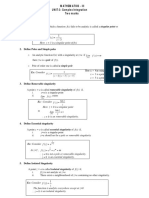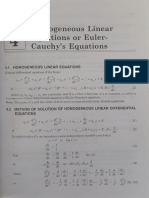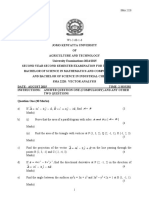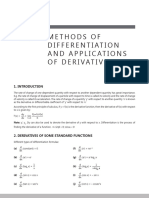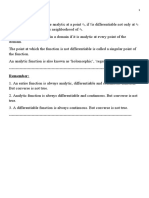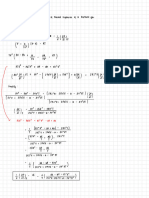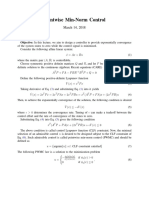1
Complex Integration
Line integral of a complex function:
b
In case of real variable, the path of integration of ∫ f ( x ) dx is always along the x−¿axis
a
from x=a to x=b .
b
But in case of a complex function f ( z ) the path of the definite integral ∫ f ( z ) dz can be
a
along any curve from z=a to z=b .
z=x +i y ⟹ dz=dx +i dy …(1)
dz=dx if y =0 …(2) and dz=i dy if x=0 …(3)
In (1), (2), (3) the direction of dz are different. Its value depends upon the path
(curve) of integration. But the value of integral from a to b remains the same along
any regular curve from a to b .
In case the initial point and the final point coincide thenc is a closed curve, then this
integral is called contour integral and is denoted by ∮c f (z )dz
If f ( z )=u ( x , y )+i v (x , y) then since dz=dx+ idy
We have, ∮c f (z )dz =∫ c ( u+iv ) ( dx +idy )
¿ ∫ c ( u dx−v dy )+i ∫ c (v dx+u dy )
which shows that the evaluation of the line integral of a complex function can be
reduced to the evaluation of two line integrals of real functions.
------------------------------------------------------------------------------------------------------
Examples on line integral4:
2+i
Example1: Evaluate ∫ ( ź )2 dz along the real axis from z=x +iy=0to
0
z=x +iy=2 and then along a line parallel to y−¿axis from z=2to z=2+i
z=x +iy=2
2+i 2+i Y
2 2
Solution: Given, ∫ ( ź ) dz=∫ ( x−iy ) (dx +idy)
0 0 B
¿ ∫ OA (x ¿¿ 2) dx + ∫ AB ( 2−iy )2 idy ¿
1
Along OA, y=0 , dy=0 , x varies 0 ¿2 O A
1 2 X
2
Along AB, x=2 , dx=0 , y varies 0 ¿ 1
2+i 2 1
∴ ∫ ( ź ) dz =∫ x dx +∫ (2−iy )2 idy
2 2
0 0 0
2 1
¿ ∫ x 2 dx +i ∫ (4−4 iy− y 2) dy
0 0
2 1
x3 y3
¿[ ] [
3 0
+i 4 y−2 i y 2−
3 ] 0
8 1 8 i
[ ]
¿ +i 4−2i− = + [ 12−6 i−1 ]
3 3 3 3
8 i
¿ + [ 11−6 i ]
3 3
1
¿ [ 8+11i+6 ]
3
1
¿ [ 14+11i ] ( Ans .)
3
which is the required value of the given integral.
-----------------------------------------------------------------------------------------------------
1+i
Example2: Evaluate ∫ (x 2−iy)dz along the path a ¿ y=x b ¿ y=x 2
0
Example3: Integrate z 2 along the straight line OM and also the path OLM consisting of
two line segments OLand OM where O is the origin. L is the point z=3and M is the
point z=3+i .
2
Example4: Evaluate ∫ (12 z −4 iz)dz along the curve C joining the points (1, 1) and (2,
3).
-----------------------------------------------------------------------------------------------------
Diagram:
C1
a
C
3
Figure-Cauchy’s Integral Formula
Cauchy’s Integral Theorem:
Statement: If a function f ( z ) is analytic and its derivative f ' ( z ) continuous at all
points inside and on a simple closed curvec , then ∫ c f ( z ) dz=0
Proof: Let the region enclosed by the curveC be Rand let
f ( z )=u+ i v, z=x +i y ⟹ dz=dx +i dy
∴ ∫ c f ( z ) dz =∫ c ( u+i v ) (dx +idy )
¿ ∫ c (u dx−v dy )+ i ∫ c (v dx+u dy)
¿ ∬R ( −∂∂ xv − ∂∂uy ) dx dy +i ∬ ( ∂∂ux − ∂∂ vy ) dx dy
c
[ by Gree n' s theorem ]
∂u
−∂ v ∧∂ v ∂u
Replacing ∂ x by ∂ y by ∂ x ,we get
∂y
∴ ∫ c f ( z ) dz =∬ R ( ∂∂ uy − ∂∂uy ) dx dy +i ∬ ( ∂∂ux − ∂∂ ux ) dx dy
c
¿ 0+i 0=0
∴ ∫ c f ( z ) dz =0 (Proved).
-----------------------------------------------------------------------------------------------------
(If there is no pole inside and on the contour then the value of the integral of the
function is zero)
-----------------------------------------------------------------------------------------------------
Examples on Cauchy’s Integral theorem2:
3 z 2 +7 z +1 1
Example1: Find the integral ∫ c dz where C is the circle |z|=
z +1 2
Solution: Poles of the integrand are given by putting the denominator equal to zero.
z +1=0 ⟹ z=−1
4
1 1
The given circle |z|= 2 with the center at z=0 and radius 2 does not enclose any
3 z 2 +7 z +1
singularity of the given function ∫ c =0 (Ans.)
z +1
( by Cauch y ' s Integral theorem )
2 z 2+ 5
Example2: Find the integral ∮c 2
dzwhere C is the square with the vertices
( z+ 2 ) ( z 2 +4 )
at 1+i ,2+i ,2+2 i ,1+2 i.
Cauchy’s Integral Formula:
Statement: If f ( z )is analytic within and on a closed curve C and if ' a ' is any point
1 f (z )
within C , then f ( a )= ∫c dz.
2 πi z−a
f (z )
Proof: Consider the function which is analytic at all points within C , except
z−a
z=a with the point ' a 'as centre and radius r draw a small circle C 1, lying entirely
within C .
f (z)
Now is analytic in the region between C and C 1, hence by Cauchy’s Integral
z−a
theorem for multiple connected region, we have
f (z ) f (z) f ( z ) −f ( a )+ f (a)
∫c dz= ∫ c dz=∫ c dz
z−a z −a
1 1
z −a
f ( z )−f ( a ) dz
¿ ∫c dz +f ( a ) ∫ c −−−−(1)
1
z−a 1
z−a
For any point on C 1.
2π iθ
f ( z )−f ( a ) f ( a+r e )−f (a) iθ
i r eiθ dθ z−a=r eiθ
Now, ∫ c
z−a
1
dz ¿ ∫
0 re
iθ
∴ dz=ir e dθ [ ]
2π
¿ ∫ [ f ( a+r e iθ ) −f ( a) ] i dθ
0
¿ 0 [ where r tends¿ 0 ]
2π 2π
dz ir e iθ 2π
And ∫ c =∫ iθ dθ=∫ i dθ= [ i θ ] 0 =2 πi
1
z −a 0 re 0
Putting the values of the integrals in R.H.S of (1), we have
5
f (z )
∫c dz=0+ f (a) 2 πi
z−a
1 f (z)
⇒ f ( a )= ∫c dz .(Proved).
2 πi z−a
-----------------------------------------------------------------------------------------------------
Diagram:
C1
a
C
Figure-Cauchy’s Integral Formula
Cauchy’s Integral Formula for the derivative of an analytic function:
Statement: If a function f ( z ) is analytic in a region R, then its derivative at any point
1 f (z )
z=a of R is also analytic in R and is given by f ' ( a )=
∫c dz
2 πi ( z−a)2
where C is any closed curve in R surrounding the point z=a .
Proof: We know, Cauchy’s integral formula
1 f (z )
f ( a )= ∫c dz … … … (1)
2 πi z−a
Differentiating ( 1 ) w.r.to ' a ' , we get
6
1 ∂ 1
f ' (a)=
2 πi
∫ c f ( z) ( )
∂ a z−a
dz
1
¿ ∫ f ( z ) . (−1 ) . ( z −a )−2 (−1 ) dz
2 πi c
1 f ( z)
⇒ f ' (a )= ∫c dz (Proved).
2 πi ( z−a)2
-----------------------------------------------------------------------------------------------------
' ( a) 2! f ( z) n! f ( z)
Similarly, f ' = 2 πi ∫ c dz f n (a)= ∫ dz
(z −a)3
2 πi c (z−a)n+1
-----------------------------------------------------------------------------------------------------
Liouville’s Theorem:
Statement: If a function f ( z )is analytic for all finite values of z and is bounded, is
a constant.
Proof: Since f ( z ) is bounded so|f ( z )|≤ M where M is positive constant.
Let z 1 , z 2 be any two points of the z−¿plane.
Let us draw a circle with center at origin and large radius R enclosing the points z 1∧z 2
. So that R>|z 1| and R>|z 2|
1 f ( z) 1 f ( z)
∴ f ( z 1 )−f ( z2 ) = ∫c dz− ∫c dz
2 πi z−z 1 2 πi z−z 2
[ by Cauchy , s Integral formula ]
1 z 1−z 2
¿ ∫c f (z)dz
2 πi ( z−z 1)( z− z2 )
1 z 1−z 2
⟹|f ( z 1 )−f ( z 2 )|=
| ∫c
2 πi ( z−z 1)( z−z 2)
f (z ) dz
|
¿ |21πi| ∫ ||zz−z−z||||z−z
c
1
1
f (z)|
2
|
|dz|
2
1 |dz|
≤
2π
|z 1−z 2|. M . ∫ c [ ∵|f (z)|< M ]
(|z|−|z 1|)(|z|−|z 2|)
7
1 |z 1−z 2|. M
≤ ∫ |dz|[ ∵|z|=R ]
2 π [ R−|z 1|][ R−|z 2|] c
∵ z=R eiθ
¿
1 | z1 −z2|. M 2 π
∫ R dθ
2 π [ R−|z1|][ R−|z 2|] 0 [ dz =iR e iθ dθ
|dz|=|iR e iθ dθ|=R dθ ]
( z1− z2 ) M .2 πR
¿ =0 Since R → ∞
2 π [ R−| z1|][ R−|z 2|]
Hence, f ( z 1 ) −f ( z 2 )=0 ⟹ f ( z 1 ) =f ( z 2 )
∴ f ( z ) is constant. (Proved).
------------------------------------------------------------------------------------------------------
Examples on Cauchy’s Integral Formula10:
dz
Example1: Prove that ∫ c z−a =2 πi where C is the circle |z−a|=r
dz
Solution: We have ∫ c z−a where c is the center (a, 0) and radius r.
Y
r
C X
O
O (a, 0)
f (z)
By Cauchy’s integral formula, ∫ c dz=2 πi . f (a)
z−a
1 1
⟹ ∫c dz =2 πi .1 ⟹ ∫c dz =2 πi ( Proved)
z−a z−a
1
Example2: Evaluate the integral ∫ c z cosz dz where C is the ellipse 9 x 2+ 4 y 2=1.
2 z +1 1
Example3: Use Cauchy’s integral formula to calculate ∫ c 2 dz where C is |z|= 2
z +z
8
z
Example4: Use Cauchy’s integral formula to calculate ∫ c 2
dz
z −3 z +2
ez
Example5: Evaluate ∫ c dz where C is the circle with center at origin and
(z−1)(z−4)
radius 2.
e zt
Example6: Show that ∫ c dz=2 πi sint if t >0and C is the circle|z|=3.
z2 +1
z 2+ 1=0 z 2=−1 z=±i
dz
Example7: Evaluate ∫ c 2 where C is the circle with center at origin and radius 2.
z −1
4−3 z 3
Example8: Evaluate ∫ c z( z −1)( z−2) dz where C is the circle |z|= 2 .
Solution: Poles are given by putting the denominator equal to zero. ∴ z ( z−1 ) ( z−2 )=0
⟹ z=0 , 1 ,2
O O X
O
1 3 2 3
The integrand has three 2simple poles at ¿ 0 , 1 ,2 . The given circle |z|= 2 with center at
3
z=0 and radius= encloses two poles z=0 , z=1.
2
4−3 z 4−3 z
4−3 z ( z−1)( z−2) z(z −2)
∴ ∫c dz= ∫ c dz+ ∫ c dz
z ( z−1)(z−2) z (z−1)
4−3 z 4−3 z
¿ 2 πi
[ ( z−1)( z−2) ] z=0
+2 πi
[ z(z −2) ] z=1
4 4−3
¿ 2 πi . + 2 πi.
(−1)(−2) (1)(−1)
¿ 2 πi ( 2−1 )=2 πi ( Ans.)
which is the required value of the given integral.
-----------------------------------------------------------------------------------------------------
3 z 2+ z +1
Example9: Evaluate ∫ c 2 dz where C is the circle |z|=3.
( z −1 ) ( z +3 )
z 2+1 3
Example10: Evaluate ∫ c 2 dz where C is the circle i)|z|= 2 ii)|z−1|=1 iii)
z −1
1
|z|= .
2
-----------------------------------------------------------------------------------------------------











